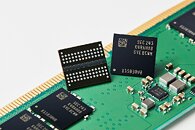TheLostSwede
News Editor
- Joined
- Nov 11, 2004
- Messages
- 17,788 (2.42/day)
- Location
- Sweden
| System Name | Overlord Mk MLI |
|---|---|
| Processor | AMD Ryzen 7 7800X3D |
| Motherboard | Gigabyte X670E Aorus Master |
| Cooling | Noctua NH-D15 SE with offsets |
| Memory | 32GB Team T-Create Expert DDR5 6000 MHz @ CL30-34-34-68 |
| Video Card(s) | Gainward GeForce RTX 4080 Phantom GS |
| Storage | 1TB Solidigm P44 Pro, 2 TB Corsair MP600 Pro, 2TB Kingston KC3000 |
| Display(s) | Acer XV272K LVbmiipruzx 4K@160Hz |
| Case | Fractal Design Torrent Compact |
| Audio Device(s) | Corsair Virtuoso SE |
| Power Supply | be quiet! Pure Power 12 M 850 W |
| Mouse | Logitech G502 Lightspeed |
| Keyboard | Corsair K70 Max |
| Software | Windows 10 Pro |
| Benchmark Scores | https://valid.x86.fr/yfsd9w |
Samsung Electronics, a world leader in advanced memory technology, today announced that its 16-gigabit (Gb) DDR5 DRAM, which utilizes the industry's most advanced 12 nanometer (nm)-class process technology, has started mass production. Samsung's completion of the state-of-the-art manufacturing process reaffirms its leadership in cutting-edge DRAM technology.
"Using differentiated process technology, Samsung's industry-leading 12 nm-class DDR5 DRAM delivers outstanding performance and power efficiency," said Jooyoung Lee, Executive Vice President of DRAM Product & Technology at Samsung Electronics. "Our latest DRAM reflects our continued commitment to leading the DRAM market, not only with high-performance and high-capacity products that meet computing market demand for large-scale processing but also by commercializing next-generation solutions that support greater productivity."


Compared to the previous generation, Samsung's new 12 nm-class DDR5 DRAM reduces power consumption by up to 23% while enhancing wafer productivity by up to 20%. Its outstanding power efficiency makes it the ideal solution for global IT companies that want to reduce the energy consumption and carbon footprint of their servers and data centers.
Samsung's development of 12 nm-class process technology was made possible thanks to the use of a new high-κ material that helps increase cell capacitance. High capacitance results in a significant electric potential difference in the data signals, which makes it easier to accurately distinguish them. The company's efforts to lower operating voltage and reduce noise have also helped deliver the optimal solution that customers need.
Boasting a maximum speed of 7.2 gigabits per second (Gbps)—translating into speeds that can process two 30 GB UHD movies in about a second—Samsung's 12 nm-class DDR5 DRAM lineup will support a growing list of applications including data centers, artificial intelligence, and next-generation computing.
Samsung completed its 16-gigabit DDR5 DRAM evaluation for compatibility with AMD last December, and continues to collaborate with global IT companies to drive innovation in the next-generation DRAM market.
View at TechPowerUp Main Site | Source
"Using differentiated process technology, Samsung's industry-leading 12 nm-class DDR5 DRAM delivers outstanding performance and power efficiency," said Jooyoung Lee, Executive Vice President of DRAM Product & Technology at Samsung Electronics. "Our latest DRAM reflects our continued commitment to leading the DRAM market, not only with high-performance and high-capacity products that meet computing market demand for large-scale processing but also by commercializing next-generation solutions that support greater productivity."


Compared to the previous generation, Samsung's new 12 nm-class DDR5 DRAM reduces power consumption by up to 23% while enhancing wafer productivity by up to 20%. Its outstanding power efficiency makes it the ideal solution for global IT companies that want to reduce the energy consumption and carbon footprint of their servers and data centers.
Samsung's development of 12 nm-class process technology was made possible thanks to the use of a new high-κ material that helps increase cell capacitance. High capacitance results in a significant electric potential difference in the data signals, which makes it easier to accurately distinguish them. The company's efforts to lower operating voltage and reduce noise have also helped deliver the optimal solution that customers need.
Boasting a maximum speed of 7.2 gigabits per second (Gbps)—translating into speeds that can process two 30 GB UHD movies in about a second—Samsung's 12 nm-class DDR5 DRAM lineup will support a growing list of applications including data centers, artificial intelligence, and next-generation computing.
Samsung completed its 16-gigabit DDR5 DRAM evaluation for compatibility with AMD last December, and continues to collaborate with global IT companies to drive innovation in the next-generation DRAM market.
View at TechPowerUp Main Site | Source



